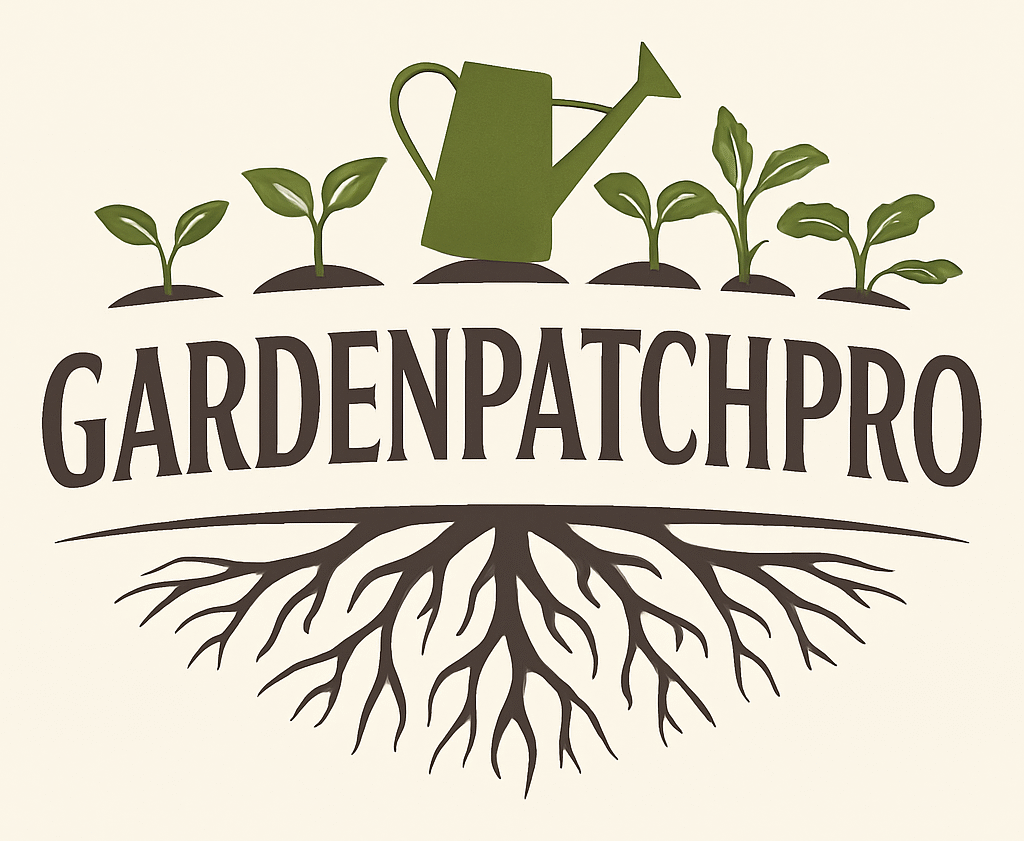14 Fairy Garden Ideas to Enhance Your Outdoor Space Creatively
Fairy gardens offer a creative way to bring small, magical scenes to life using plants, tiny decorations, and miniature furniture. They can add charm to any outdoor or indoor space and provide a fun project for both kids and adults.
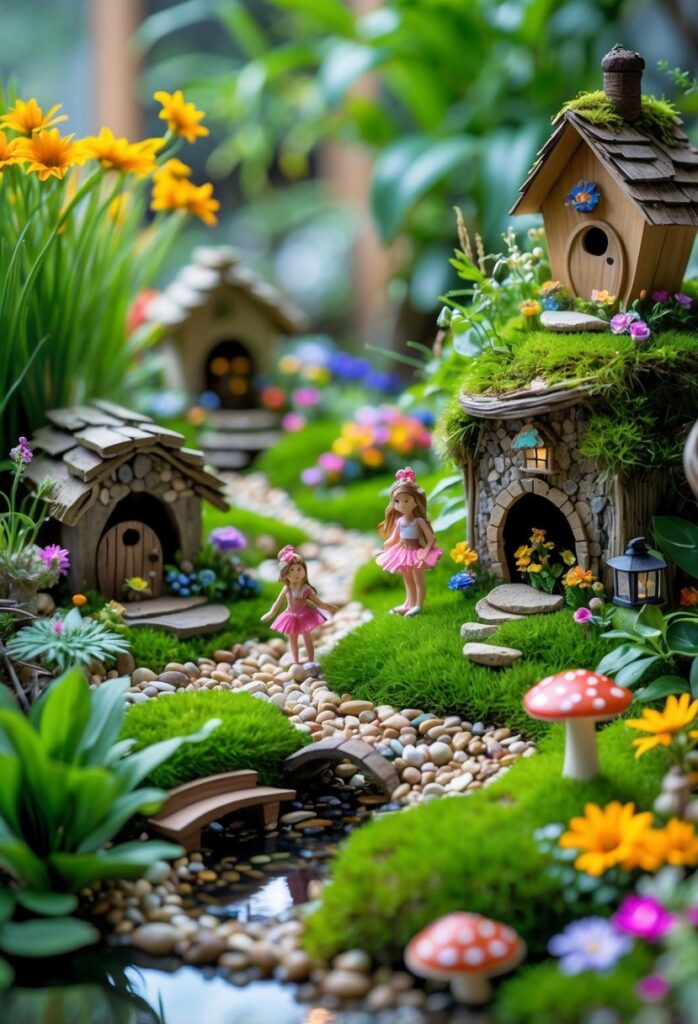
This article shares 14 fairy garden ideas that help anyone create their own enchanting miniature world with simple materials and thoughtful designs. These ideas aim to inspire creativity while making the process easy and enjoyable.
1) Miniature mushroom garden with LED lights
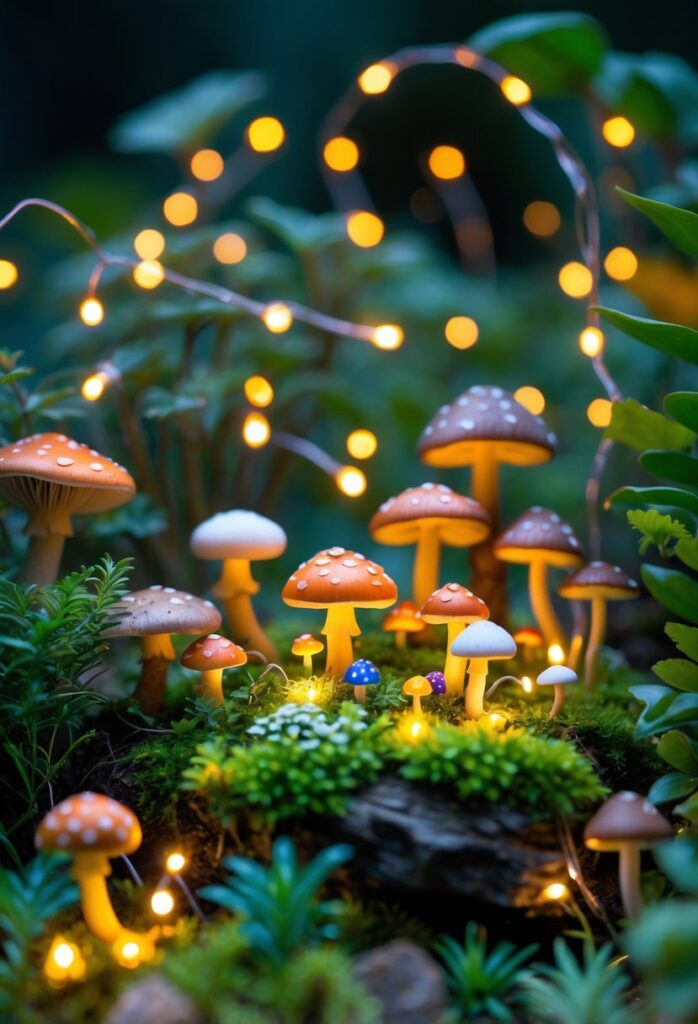
A miniature mushroom garden adds charm and a natural feel to any fairy garden. Small mushrooms can be made from clay or painted rocks. They give a whimsical touch without taking up much space.
Adding LED lights inside or around the mushrooms creates a soft glow at night. This makes the garden look magical after dark. Small LED mushrooms or tiny lights hidden under hollow mushrooms work well for this effect.
Using LED lights is practical because they use little energy and last a long time. Solar-powered options are available, so there’s no need for wires or batteries. This allows the garden to glow naturally once the sun sets.
Tiny glowing mushrooms paired with moss and small fairy houses create a peaceful scene. This setup brings a warm and cozy atmosphere to a miniature garden. For ideas, explore how to make glowing fairy garden mushrooms with LED lights in a detailed mushroom crafts guide.
2) Teacup fairy garden with succulents
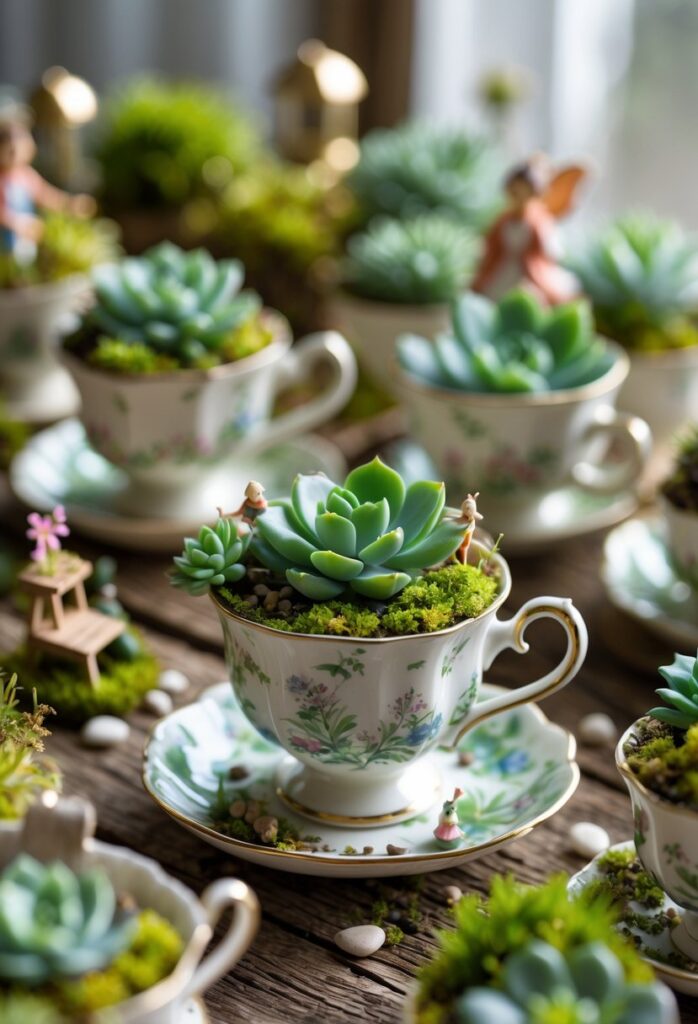
A teacup fairy garden with succulents is a simple and charming way to add a touch of greenery indoors or outdoors. It starts with selecting a vintage or decorative teacup as the base. Succulents like echeveria or zebra plants work well because they are small and require little water.
The teacup acts as a tiny planter. Filling it with soil and carefully placing the succulents creates a compact and neat look. Small accessories such as miniature fairy figurines or stones can add interest without overcrowding the space.
This type of garden is low maintenance and fits in small areas. It can brighten up a desk, windowsill, or shelf. A teacup fairy garden with succulents is also a popular DIY project for beginners since it needs few materials and is quick to assemble. More ideas and examples can be found in this guide on teacup fairy garden ideas with succulents.
3) DIY fairy house from reclaimed wood
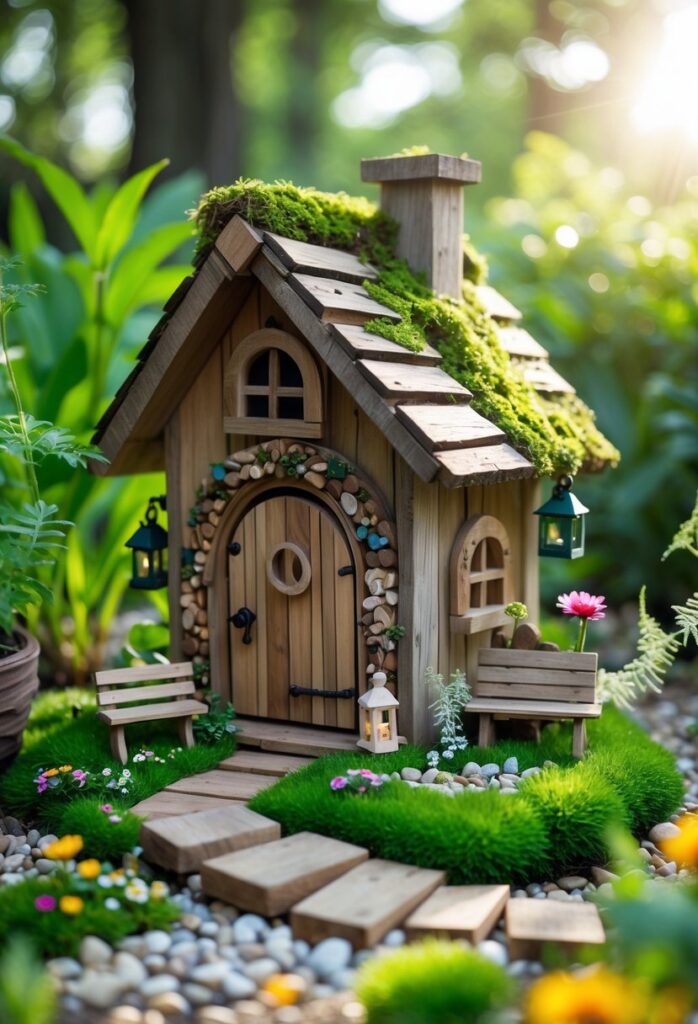
Using reclaimed wood is a great way to build a fairy house while being eco-friendly. Scrap wood pieces, like old pallets or branches, provide a natural look that fits well in a garden setting.
The wood can be cut and shaped into walls, roofs, and doors. Bark cut offs or natural edge slabs add texture and charm to the design. These materials often have worn edges that give the house a rustic feel.
To build the house, basic tools like a small saw and glue are enough. The project allows creativity with adding tiny windows, shingles, or small stairs. Reclaimed wood is easy to work with and durable outdoors.
This method also helps recycle leftover wood that might otherwise be thrown away. People can find inspiration and tips from those who share their work, such as in online communities focused on fairy garden crafts like the one on Fairy Home Tour.
4) Fairy garden swing made from twigs

A fairy garden swing made from twigs adds a playful and charming touch to any miniature garden. It can be built using a few simple materials like twigs, string, or thin wire. Choosing the right size of twigs helps keep the swing in scale with the rest of the garden.
The seat can be made from a small piece of bark, a flat stone, or a tiny wooden plank. The twigs act as the frame and the support for the swing. Attaching the seat to the frame with natural string or twine gives it a rustic look.
Building the swing requires some basic assembly steps. The frame is made by tying twigs together, making sure it is sturdy enough to hold the seat. The swing should hang freely from the frame, allowing it to move gently in the breeze.
A fairy swing is especially nice when placed under a tiny tree or near a fairy house. It creates a scene that feels lived in and inviting. More details on creating these swings can be found in guides for DIY fairy garden accessories.
5) Tiny fairy door on a tree trunk
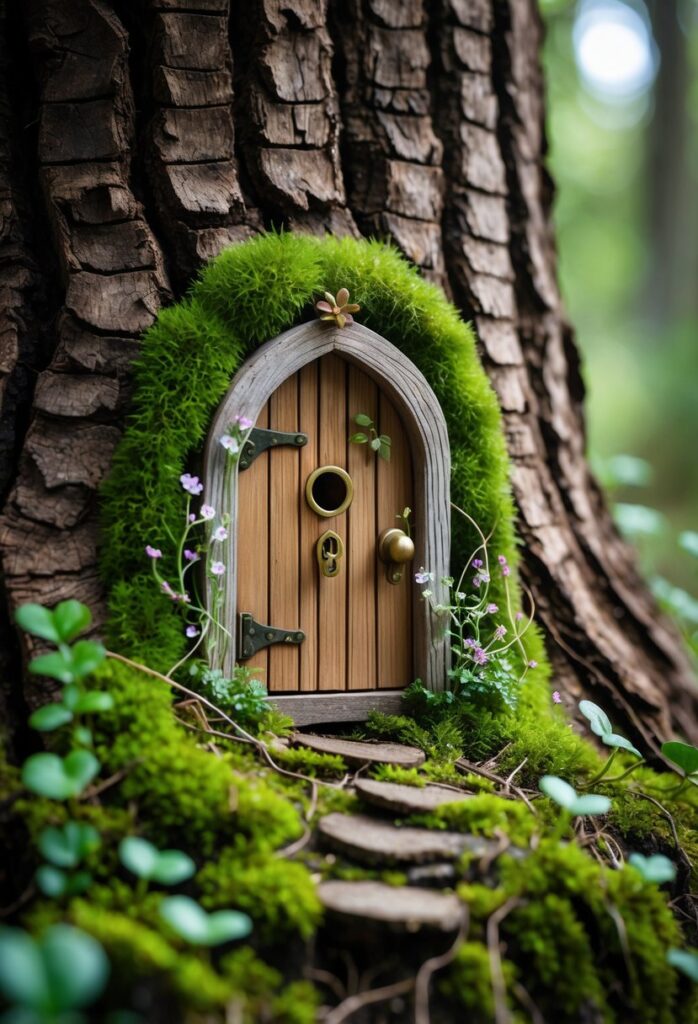
A tiny fairy door attached to a tree trunk creates a simple yet charming focal point in any garden. It adds a magical touch by making the tree look like a small home for fairies.
The door can be made from wood, resin, or other weather-resistant materials. It should be small enough to fit naturally on the bark without damaging the tree.
To blend the door into the setting, adding natural decorations like moss and small stones works well. This helps the door look like part of the forest environment.
Some designs include extra details such as miniature windows or tiny ladders. These small additions bring more life and realism to the fairy house.
Attaching the door carefully ensures it stays in place while keeping the tree healthy. This is a popular idea for creating a magical backyard scene that encourages imagination. More ideas can be found in this collection of fairy door inspirations for trees.
6) Pebble pathway lined with mini flowers
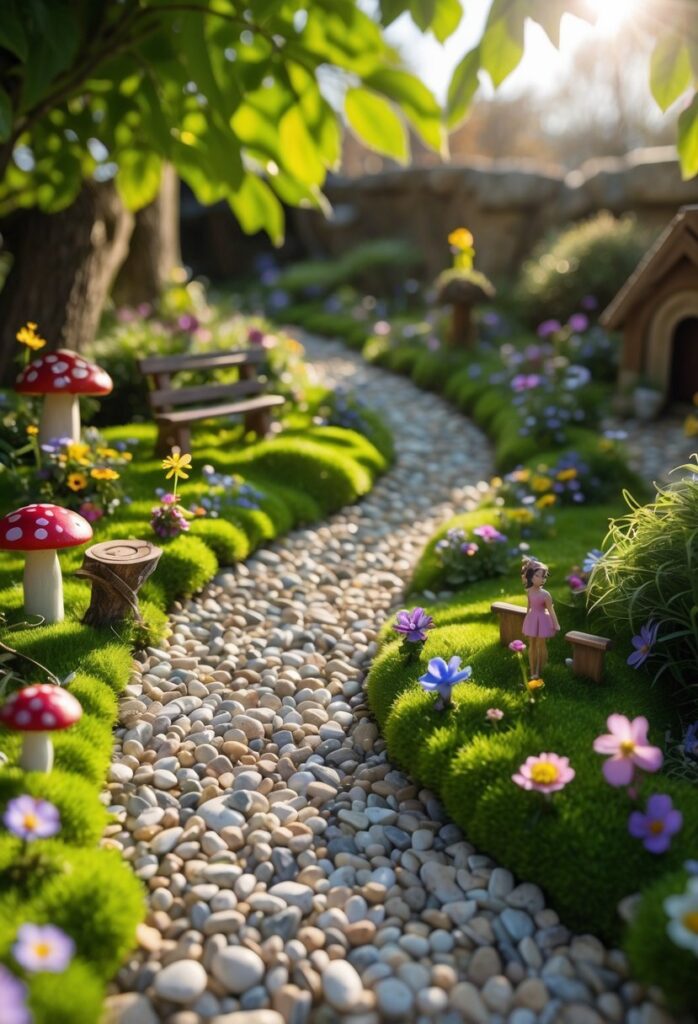
A pebble pathway adds structure and charm to a fairy garden. It guides the eye and creates a clear walking route. Small, smooth pebbles work best for a neat and natural look.
Lining the pathway with mini flowers enhances the beauty. Tiny blooms in bright colors make the path inviting and lively. Flowers like mini daisies or creeping thyme fit well along the edges.
The mix of pebbles and flowers creates balance. The hard texture of the stones contrasts nicely with soft petals. This combination gives the garden a whimsical and cared-for feel.
Arranging the pebbles in a curved or winding shape adds more interest. It mimics natural paths and invites exploration. Adding moss or tiny garden figurines near the path adds extra detail and magic.
This idea is simple but effective for any fairy garden style. It helps divide space while keeping the look delicate. Using different flower colors along the edges creates a pleasing pattern to enjoy.
For more ideas on creating charming pebble paths, visit 22 Miniature Fairy Garden Ideas That Are Bursting With Charm and Creativity.
7) Miniature water fountain with stones
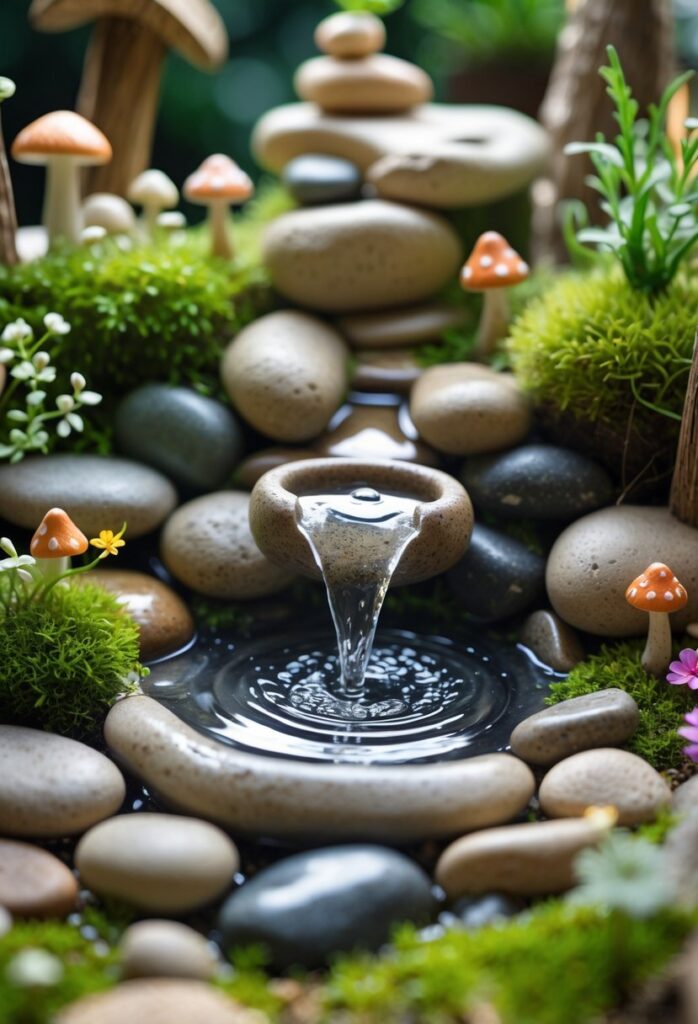
A miniature water fountain with stones adds a natural feel to any fairy garden. Small fountains can be built using a tiny pump to keep water flowing gently. Stones placed around the fountain help hide the pump and create a realistic look.
Using different sizes and colors of stones gives texture and depth. The stones also help direct the flow of water, making the fountain feel more peaceful. This setup mimics real garden fountains on a smaller scale.
The pump should have a low head rating, about 12 inches, to work well in tiny spaces. A steady, soft trickle of water creates calm sounds without being too loud. Household items like small watering cans or containers can be part of the design.
This type of fountain becomes a lovely focal point in the garden. It fits well with plants, fairy houses, and other small decorations. For ideas and detailed instructions, see how to create a miniature fairy garden fountain with stones and helpful tips.
More ideas can be found on how to make a fairy tale garden water fountain.
8) Fairy garden bench from bark pieces
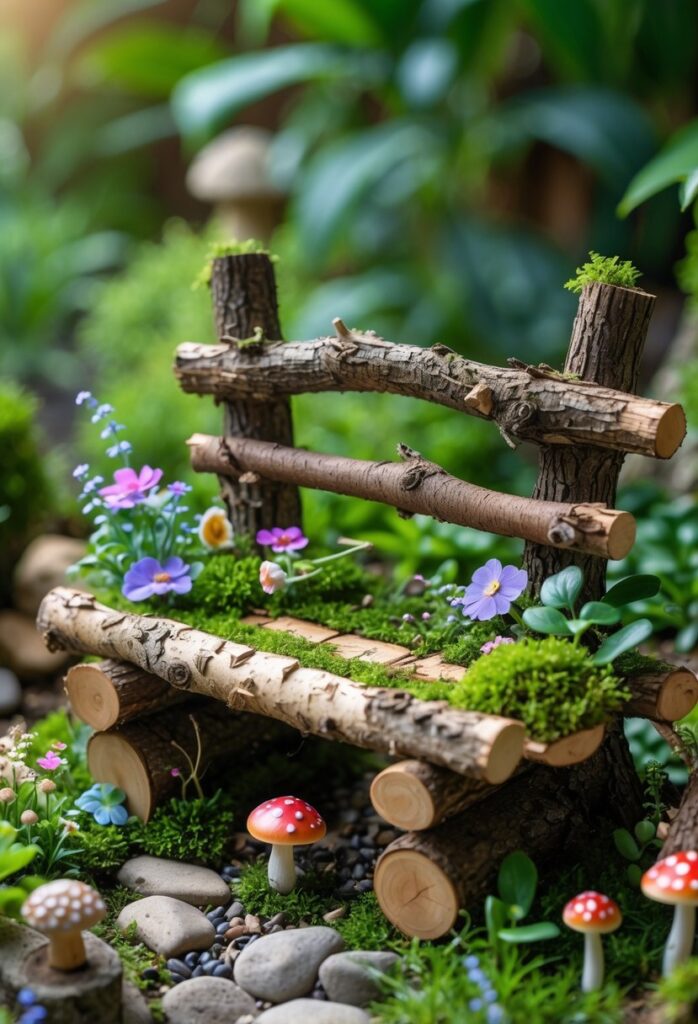
A fairy garden bench made from bark pieces adds a natural touch to any miniature outdoor space. It fits well with woodsy themes and looks like it belongs in a tiny forest.
To make the bench, it helps to collect flat bark pieces and small twigs. These materials create the seat and legs. Cutting twigs to the right size ensures the bench is balanced and sturdy.
Assembling the bench is simple. Twigs can be glued or tied together to build a frame. Then, the flat bark pieces are placed on top for the seat.
Adding small details like a smooth stone for a backrest or tiny leaves can improve the bench’s look. Natural materials make the bench blend with other fairy garden elements.
This project allows for creativity while using easy-to-find items. It’s a practical way to enhance the charm of a fairy garden woodland scene. For more ideas on fairy garden benches and furniture, visit 20 Magical Fairy Garden Ideas to Inspire You.
9) Fairy garden fence crafted from popsicle sticks
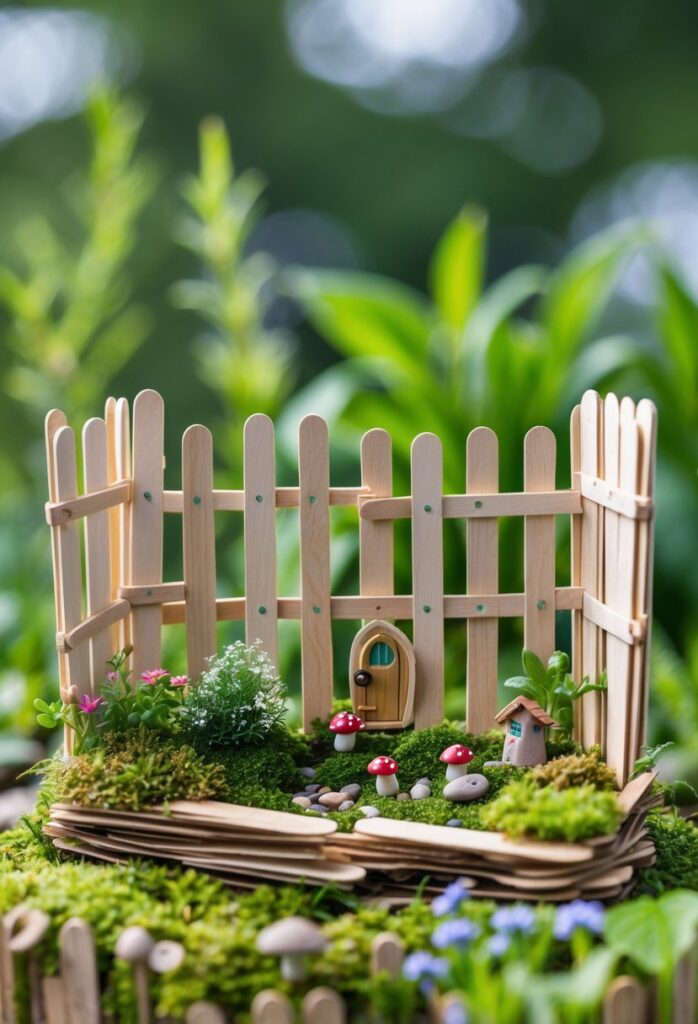
A fairy garden fence made from popsicle sticks is simple and neat. It adds a classic border that helps define the space clearly.
To make the fence, popsicle sticks are lined up vertically or horizontally. They are glued together to hold the shape. For extra strength, wire can be added between the sticks.
The fence can be cut to any height needed. Painting it adds color or helps it blend with the garden. This gives a little flair while keeping a realistic look.
This project is great for beginners. It uses basic materials like glue and sticks, which are easy to find. It also allows room for creativity by changing the style and paint.
More tips and creative ideas can be seen in the DIY Fairy Garden Fencing Ideas guide. This helps craft a fence that fits well in any miniature garden setup.
10) Miniature clay mushroom clusters
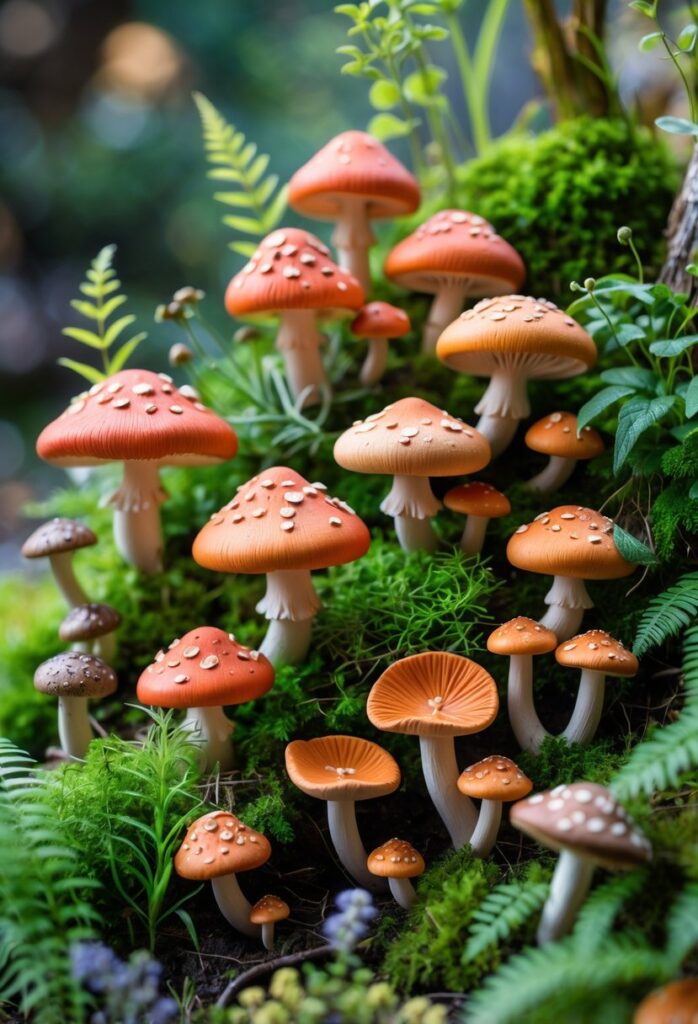
Miniature clay mushroom clusters add charm and detail to any fairy garden. These small groups of mushrooms can be made using air-dry or polymer clay, allowing for durable and weatherproof decorations. Their size makes them perfect for creating focal points in tiny garden spaces.
The mushrooms can be designed with simple caps or painted with colorful dots to make them stand out. Clusters of mushrooms give a natural, forest-like look, which fits well with fairy garden themes. They also create a sense of magic by mimicking real mushroom growth patterns in damp, shady areas.
Using clay lets gardeners customize the shapes and colors for personal style. This craft can also be a fun activity for children since it requires no oven heating with air-dry clay options. Adding miniature clay mushrooms enhances the detail and creativity of any miniature fairy garden setup.
For a detailed guide on making durable clay mushrooms, see this DIY tutorial on air-dry clay fairy garden mushrooms.
11) Fairy garden tents using fabric scraps
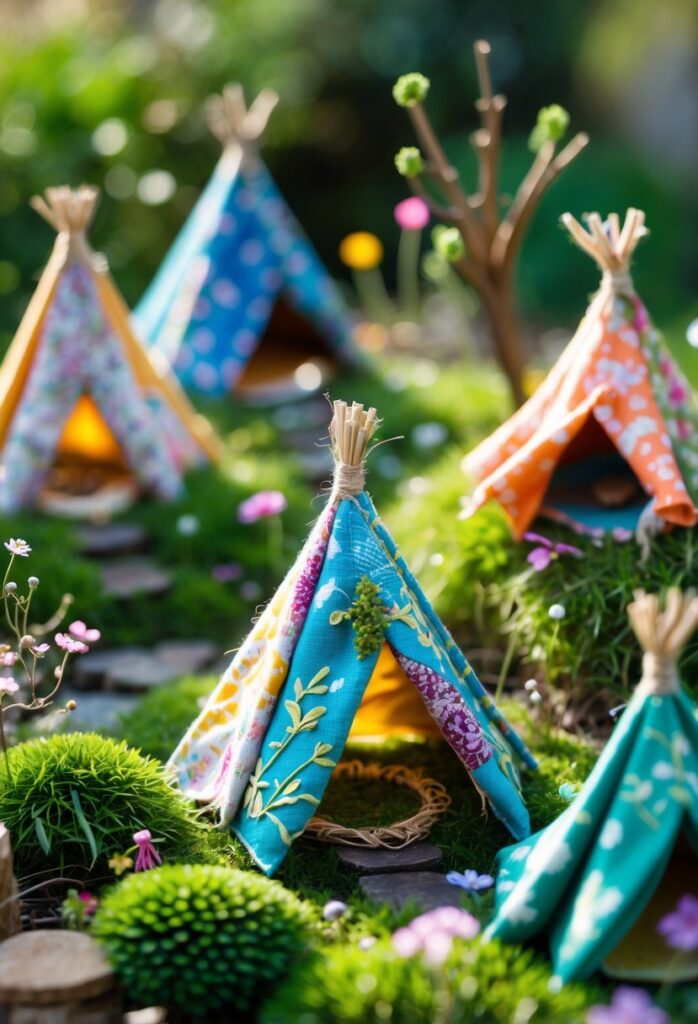
Creating fairy garden tents is a simple way to add charm and a cozy feel to a miniature garden. Small tents can be made using fabric scraps, which offer a variety of colors and patterns to choose from.
To build a tent frame, sticks or skewers are glued or tied together in a basic triangular shape. Fabric scraps are then cut to fit over the frame and attached with glue or tied at the corners.
These tents create tiny hideaways for fairy figures and help make the garden feel more magical. Using recycled fabric also keeps the project budget-friendly and eco-friendly.
Adding details like miniature pillows or rugs made from leftover fabric helps enhance the look. These tents fit well with other garden elements such as tiny paths or fairy houses.
This idea is practical and creative, making it a popular choice for fairy garden enthusiasts. For more inspiration on making fairy tents and decorations, see ideas from HGTV and other DIY sources.
12) Miniature fairy table with chairs

A miniature fairy table with chairs adds a charming touch to any fairy garden. It creates a small, cozy spot that invites imagination and adds detail to the scene.
These tiny furniture sets can be made from various materials like wood, clay, or even repurposed household items. For example, acorn caps can serve as bowls on the table, enhancing the tiny setting.
Placing the table among small plants or moss makes the area feel more natural. Adding decorations like leaves, flowers, or tiny fairy figurines can make the set look ready for a fairy tea party.
Many DIY ideas help create unique miniature furniture to fit any style, from rustic to whimsical. A small teacup or vintage teapot can also be used as part of the table setting for a creative twist.
Detailed miniature tables and chairs bring personality to the garden and make it easy to imagine a tiny world where fairies rest and gather. More ideas for this can be found in the collection of miniature fairy table and chairs.
13) Hollow log fairy hideout

A hollow log makes a natural and charming hideout for a fairy garden. It can be filled with moss to create soft bedding. Small acorn dishes can serve as fairy dining spots inside the log.
Placing the log where it stays mostly dry helps protect the fairies’ home. Sealing the bottom with beeswax can also keep moisture out. Uneven stones nearby can act as miniature steps leading up to the hideout.
Adding tiny decorations like bark fairy doors or little woodland creatures brings the space to life. Shelves or miniature tools can turn the hollow log into a fairy’s workshop or kitchen. This keeps the fairy home feeling cozy and full of character.
A hollow log fits well into woodland-themed gardens. It works with natural shapes and textures, making it easy to blend into the outdoor space. This idea is simple but effective for creating a fairy haven outdoors.
More ideas about this can be found at 14 Enchanting Fairy Garden Ideas for Kids.
14) Miniature birdbath fountain
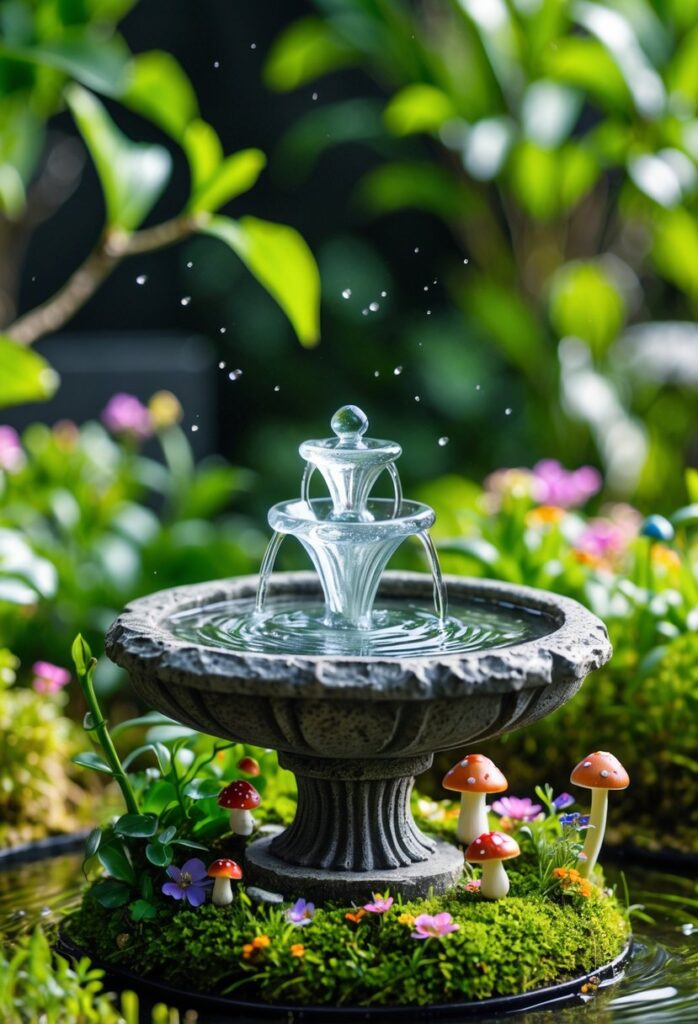
A miniature birdbath fountain adds a charming water feature to a fairy garden. It creates a gentle sound that brings life and movement to the tiny space.
These small fountains are often made from resin or other weather-resistant materials. They fit well in miniature gardens and blend with fairy figures and plants.
The fountain can be filled with water to attract birds or simply serve as decoration. Some versions mimic real birdbaths, while others include small pumps to circulate water.
Adding a miniature birdbath fountain helps create a peaceful and inviting atmosphere. It can be the centerpiece of the fairy garden or part of a larger display.
For ideas and examples, one can explore options from shops offering tiny fountains designed for dollhouses and miniature gardens, such as Miniature Birdbath Miniature Fairy Garden Polyresin Bird Bath.
Essential Materials for Fairy Gardens
Creating a fairy garden requires careful choice of containers, selecting the right plants, and adding decorative elements. Each part plays a key role in making the miniature world feel alive and charming.
Choosing the Right Containers
The container sets the foundation for a fairy garden. It needs to be durable and hold soil well to support plants. Popular choices include shallow ceramic pots, wooden boxes, and even old wheelbarrows.
Drainage is an important factor. Containers should have holes to prevent water buildup, which can harm plant roots. If not, adding a layer of gravel at the bottom helps with drainage.
Size matters too. Small containers work for simple designs with fewer plants, while larger containers can hold more details, like tiny furniture or pathways. Lightweight containers are easier to move and rearrange.
Types of Miniature Plants
Miniature plants fit the scale of fairy gardens and thrive in small spaces. Succulents like hens and chicks are popular because they need little water and have interesting shapes.
Other good choices include small ferns, moss, thyme, and creeping jenny. These plants add texture and color without growing too tall. Annuals and small flowering plants can bring seasonal color.
When selecting plants, consider sunlight and watering needs. For shady spots, moss and ferns work well. Sunny areas suit succulents and herbs. Mixing plant types creates variety and keeps the garden lively.
Decorative Elements and Tools
Decorations give the garden personality and a story. Common items include miniature houses, tiny furniture, stepping stones, and small bridges. Handmade accessories made from natural materials like twigs or pebbles add an authentic feel.
Tools like small trowels, tweezers, and paintbrushes help place and arrange tiny objects carefully. Using craft glue or waterproof sealant can secure decorations so they last longer outdoors.
Lighting, such as small solar lights or LED fairy lights, enhances the magical effect, especially at night. Simple details like colorful beads or shells also add charm without overwhelming the space.
For ideas on combining natural materials with creative touches, see this detailed guide on fairy garden elements.
Fairy Garden Maintenance Tips
Keeping a fairy garden in good shape means regular care tailored to the plants and decorations used. Attention to seasonal changes and common problems helps the garden stay attractive and healthy over time.
Seasonal Care Guidelines
Different seasons bring different challenges. In spring and summer, plants need frequent watering, especially small potted ones. It’s important to check soil moisture daily and water when the top feels dry.
During fall, fallen leaves should be cleared regularly to prevent mold and pests. Pruning dead or overgrown plants helps keep the garden tidy and encourages healthy growth.
Winter requires extra protection. Containers may need to be moved indoors or covered to avoid frost damage. Fragile decorations should be stored safely to prevent weather wear, while hardy plants can be mulched for insulation.
Troubleshooting Common Issues
Pests like aphids and snails often appear and can harm small plants. Using natural remedies such as neem oil or manually removing pests is effective. Chemicals should be avoided to protect delicate fairy garden features.
Yellowing leaves or wilting usually indicate improper watering—either too much or too little. Adjust watering habits based on the plant species and environmental conditions.
If decorations fade or break, replacing them with weather-resistant materials prolongs the garden’s charm. Checking for mold or mildew on moss and soil is key. Removing affected areas and improving airflow solves most problems quickly.
For detailed maintenance advice, visit 14 enchanting fairy garden maintenance tips.
Frequently Asked Questions
Creating a fairy garden involves choosing designs, materials, and features that balance creativity and practicality. This includes indoor setups, affordable supplies, and ways to craft a whimsical, child-friendly space with essential fairy-tale elements.
What are some creative DIY fairy garden designs?
Some popular designs include a miniature mushroom garden with LED lights for a glowing effect. A teacup fairy garden with succulents adds charm and easy care. Building a fairy house from reclaimed wood offers a rustic, natural look. A fairy garden swing made from twigs creates movement and playfulness. Adding a tiny fairy door on a tree trunk gives the garden a magical entrance.
How can I create an indoor fairy garden?
Start with a shallow container or terrarium. Use small plants like succulents or moss that need little sunlight. Add miniature furniture and accessories such as tiny houses or doors. Be sure to water sparingly to avoid mold. Proper lighting with LED fairy lights enhances the indoor magical feel.
What are affordable materials to use for a fairy garden?
Reclaimed wood makes great houses or furniture. Natural items like twigs, stones, and pinecones are inexpensive and fit the fairy theme. Small containers like old teacups or jars can hold plants. Soil and tiny plants like succulents or moss are budget-friendly. DIY elements can reduce costs further.
How do I design a garden to give it a fairytale-like aesthetic?
Use a mix of miniature plants and whimsical features like tiny fairy doors or swings. Incorporate soft lighting such as LED string lights. Choose curved pathways made from pebbles or bark. Add handcrafted fairy houses or natural decorations. Grouping items closely creates a cozy, magical look.
Can you provide steps for constructing a child-friendly fairy garden?
Choose safe, non-toxic plants and materials. Start with a simple design, like a small play area with a fairy swing or door. Use lightweight items kids can move and decorate. Teach children how to water and care for plants gently. Involve them in building miniature houses or paths for hands-on fun.
What elements are essential for an enchanted garden theme?
Key elements include miniature fairy houses, tiny doors, safe plants like moss and succulents, and natural decorations such as twigs and stones. Soft lighting adds enchantment. Moving parts like a fairy swing introduce life. Paths and seating areas help tell a story and invite exploration.
For more ideas and tips, see a comprehensive guide on fairy gardens.
